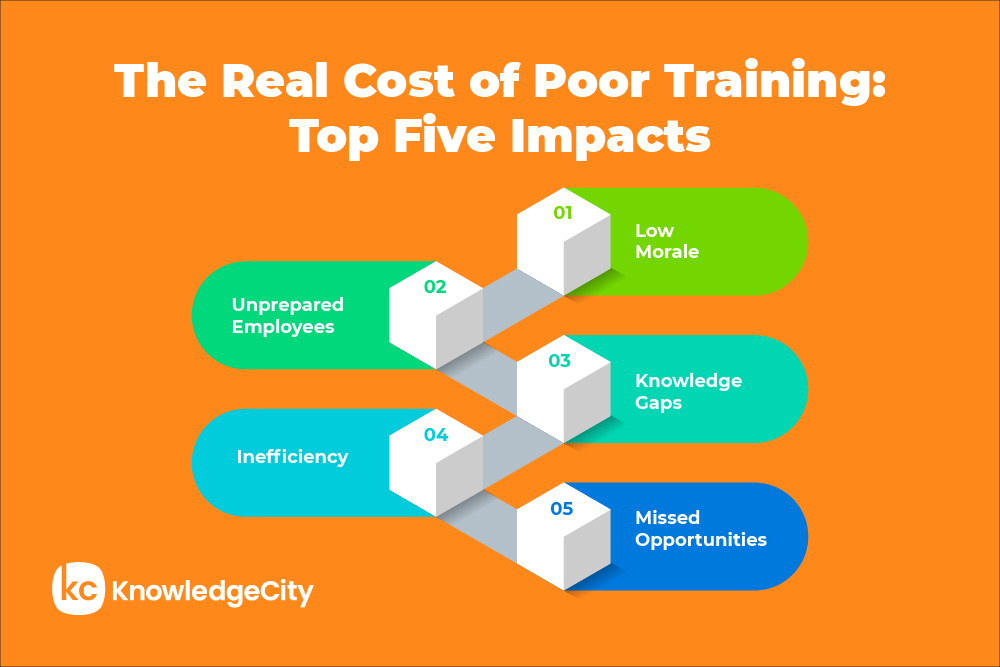In a competitive business environment, having a skilled and adaptable workforce is a must. Companies that invest in high-quality training programs are better equipped to handle change, seize opportunities, and stay ahead of the competition. This is especially important considering that 29% of employees don’t feel optimistic about their training and skill development opportunities.
Training budgets are often tight, leading some to question the return on investment. While good training programs have upfront costs, cutting corners on training can be much more damaging to a company’s bottom line.

This article highlights the hidden costs of poor employee training, such as decreased productivity, unhappy employees, and even safety risks. By looking at these hidden costs, we’ll show why investing in quality training is a smart move. It unlocks employee potential, creates a positive work environment, and drives long-term business success.
What is Low-Quality Training?
Low-quality training can hold back a company’s success. Imagine a session hastily put together, packed with outdated or irrelevant information. The instructor might be inexperienced, struggling to engage the audience, or just reading from slides without clear explanations.
This passive learning approach, where employees are expected to absorb information without interaction or practice, sets everyone up for failure. When the training ends, employees are left to figure out how to apply what they (maybe) learned on their own.
Incomplete or vague training creates knowledge gaps, making it hard for employees to do their jobs well. Unprepared employees, lacking the right skills and knowledge, will make mistakes, waste time, and frustrate customers. Feeling unsupported and inadequately trained can lead to discouragement and lower morale.
The results of poor training are clear. If you’re concerned about the quality of training at your workplace, talk to your manager or HR representative. They can provide more information and help address your concerns.
Here are some examples of poor training:
- Outdated Training: Businesses need to keep up with the times. Using outdated training materials or methods leaves employees unprepared for current situations. Imagine a customer service rep being trained on a return policy that changed months ago!
- Unorganized Training : Training should be clear and well-structured. If employees are overwhelmed with information or unclear on what they’re supposed to learn, it defeats the purpose. This can lead to frustration and a sense of being unprepared.
- Inconsistent Training: When training varies depending on the manager or trainer, employees may receive conflicting information. This creates confusion and makes it difficult for them to do their jobs effectively.
- Inconvenient Training: Scheduling training during busy hours or without enough notice shows a lack of respect for employees’ time. This can lead to resentment and a feeling that training isn’t important.
- Focus on Tasks, Not the Why :Training should go beyond just memorizing procedures. Employees should understand the bigger picture and the reasons behind their tasks. This fosters a sense of ownership and better decision-making.
The Effects of Low-Quality Training
Low-quality employee training can affect a company, impacting individual performance, customer satisfaction, and overall success. Investing in high-quality training is essential, with 71% of workers saying they feel more prepared for the future due to the training they receive. Cutting corners on training can lead to serious consequences. Here’s how poor training can hurt your business:
- Unprepared Employees: When training is unclear, employees spend more time figuring things out independently. This slows them down and hampers productivity. They may constantly seek clarifications or redo tasks due to errors.
- Decreased Productivity: Employees struggling with unclear training spend more time figuring things out independently. This slows them down and hinders their overall productivity. They might need to ask for constant clarifications, double-check their work, or redo tasks due to errors.
- Low Morale and High Turnover: According to TalentLMS, 41% of employees will look for another job in 2024 if their current company doesn’t provide training opportunities. Unsupported and inadequately trained employees often become discouraged and stressed. This can lead to disengagement and a drop in morale, resulting in higher employee turnover and increased recruitment costs.
- Knowledge Gaps and Inconsistency: Incomplete or unclear training leaves employees with gaps in their understanding. This can cause inconsistency in how tasks are performed, as some employees may follow incorrect procedures due to inadequate training.
- Customer Dissatisfaction: When employees lack the skills to handle customer inquiries or resolve issues, customer satisfaction suffers. A customer service representative struggling to answer basic questions or taking too long to address problems can frustrate customers and damage the company’s reputation.
- Safety Risks: In industries involving machinery or hazardous materials, inadequate training can pose serious safety risks. Employees not properly trained on safety protocols and procedures are more likely to get injured.
Why Is Effective Training Important?
Success depends on a skilled and empowered workforce, and good training is key to establishing both. Here’s why investing in effective training is important:
- Increased Productivity and Performance: Well-trained employees perform their jobs more efficiently, making fewer errors and completing tasks faster. They can tackle complex tasks and drive innovation.
- Improved Customer Satisfaction: Employees who know their stuff provide better service. They answer questions accurately and solve issues quickly, leading to happier customers and increased loyalty.
- Reduced Costs: Effective training reduces expenses related to errors, rework, and accidents. Skilled employees make fewer mistakes and need less supervision, saving the company money.
- Enhanced Employee Retention: Employees who feel valued and supported through training are more satisfied and engaged. This results in lower turnover rates, saving on recruitment and onboarding costs.
- Stronger Employer Brand: A company known for its commitment to employee training and development becomes a more attractive workplace to outside jobseekers. This can help attract top talent and build a strong employer brand.
- Expanded Skills and Knowledge: Effective training equips employees with the skills and competence they need to succeed. This can lead to increased feelings of confidence.
- Career Advancement Opportunities: Employees who are well-trained are ready to take on new challenges and responsibilities, making them strong candidates for promotion. Training programs can help employees develop the skills and qualifications needed for further career advancement.
- Improved Job Satisfaction: Employees who feel competent and challenged are more likely to be satisfied with their jobs. Practical training can contribute to a more positive and engaging work environment.
- Greater Adaptability: Training helps employees stay current with new skills and technologies, making them more adaptable and valuable.
Overall, practical training is a win-win situation for both employers and employees. Investing in quality training programs helps build a skilled, engaged, and productive workforce, benefiting both employees and the company.
Investing in High-Quality Training
For businesses looking to make the most of their training efforts, here’s how to get it right:
- Identify Your Needs: Start by figuring out where your team needs more skills. Use surveys, interviews, and performance reviews to spot gaps in their knowledge or abilities. With a clear picture of what’s needed, you can build a focused training program.
- Customize the Program: Forget one-size-fits-all solutions. Create training materials that address your team’s specific needs and align with your company’s goals. Offer a mix of learning methods like classroom sessions, online courses, hands-on workshops, and simulations to engage different learning styles.
- Promote Active Learning: Move beyond traditional lectures. Encourage participation with discussions, case studies, role-playing, and hands-on activities. This makes learning more interactive and effective.
- Invest in Great Trainers: Hire experienced trainers who know their stuff and can connect with your team. A passionate trainer can make a big difference, creating a positive environment where employees feel comfortable asking questions and engaging with the material.
- Provide Ongoing Support: Learning shouldn’t stop after the training session. Offer continued support through coaching, mentoring, and additional resources. Monitor how well employees are applying what they’ve learned and adjust your programs based on their feedback and performance.
- Use Technology: Incorporate tools like online learning platforms, video conferencing, and collaborative software to make training more accessible and engaging.
- Gather Feedback: Ask employees for their thoughts on the training. This helps you understand what’s working and what needs improvement.
- Get Leadership Support: When leaders show they value training, it highlights its importance to the entire organization and encourages employees to take it seriously.
By following these strategies, businesses can develop high-quality training programs that equip their workforce with the skills and knowledge they need to succeed, driving organizational growth and achieving long-term success.
Subscribe to Our Newsletter
Join 80,000+ Fellow HR Professionals. Get expert recruiting and training tips straight
to your inbox, and become a better HR manager.

 KnowledgeCity
KnowledgeCity 












